201771010135 杨蓉庆AND张燕 《面对对象程序设计(java)》第十一周学习总结
1、实验目的与要求
(1) 掌握Vetor、Stack、Hashtable三个类的用途及常用API;
(2) 了解java集合框架体系组成;
(3) 掌握ArrayList、LinkList两个类的用途及常用API。
(4) 了解HashSet类、TreeSet类的用途及常用API。
(5)了解HashMap、TreeMap两个类的用途及常用API;
(6) 结对编程(Pair programming)练习,体验程序开发中的两人合作。
一、理论知识
1、数据结构介绍
(1)一般将数据结构分为两大类:线性数据结构和 非线性数据结构。
(2)线性数据结构:线性表、栈、队列、串、数组 和文件。
(3)线性表按其存储结构可分为顺序表和链表, 用顺序存储结构存储的线性表称为顺序表;
(4)栈(Stack)也是一种特殊的 线性表,是一种后进先出 (LIFO)的结构。
(5)队列(Queue)是限定所有的插入只能在表的一端进行 ,而所有的删除都在表的另一端进行的线性表。
(6)散列表又称为哈希表;
(7)负载因子越高 (越接近1.0),内存的使用效率越高,元素的 寻找时间越长。负载因子越低 (越接近0.0),元素的寻找时 间越短,内存浪费越多。
2、JAVA的集合框架
(1)集合(Collection或称为容器 )是一种包含多个元素 并提供对所包含元素操作方法的类,其包含的元 素可以由同一类型的对象组成,也可以由不同类 型的对象组成。
(2)框架就是一个类库的集合,框架中包含很多 超类,编程者创建这些超类的子类可较方便的设 计设计程序所需的类。例如:Swing类包
(3)集合类的作用: Java的集合类提供了一些基本数据结构的支持。 – 例如Vector;
(4)集合类的使用: Java的集合类包含在java.util包中。
(5)集合类的特点:特点一: 只容纳对象。
特点二:集合类容纳的对象都是Object类的实例,一旦把一个对象置入集合类中,它的类信息将丢失;
3、JDK1.1版本中的集合类
(1)Vector中只能存放对象。
Vector的元素通过下标进行访问。
Vector类关键属性: capacity表示集合最多能容纳的元素个数。capacityIncrement表示每次增加多少容量。size表示集合当前元素个数。
(2)Vector类的关键方法: void addElement(Object obj) void add(int index, Object element) Object elementAt(int index)
(3)Stack类是Vector的子类。
Stack类描述堆栈数据结构,即LIFO。
(4)Hashtable类 :Hashtable通过键来查找元素。
Hashtable用散列码(hashcode)来确定键。所有对象都有一个散列码,可以通过Object类的 hashCode()方法获得。
2、实验内容和步骤
实验1: 导入第9章示例程序,测试程序并进行代码注释。
测试程序1:
l 使用JDK命令运行编辑、运行以下三个示例程序,结合运行结果理解程序;
掌握Vetor、Stack、Hashtable三个类的用途及常用API。
import java.util.Vector;
//示例程序1
class Cat {
private int catNumber;
Cat(int i) {
catNumber = i;
}
void print() {
System.out.println("Cat #" + catNumber);
}
}
class Dog {
private int dogNumber;
Dog(int i) {
dogNumber = i;
}
void print() {
System.out.println("Dog #" + dogNumber);
}
}
public class CatsAndDogs {
public static void main(String[] args) {
Vector cats = new Vector();//创建一个新的类
for (int i = 0; i < 7; i++)
cats.addElement(new Cat(i));
cats.addElement(new Dog(7));
for (int i = 0; i < cats.size(); i++)
if(cats.elementAt(i)instanceof Cat)// instanceof运算符是用来指出对象是否是特定类的一个实例
{
((Cat) cats.elementAt(i)).print();
}else {
((Dog) cats.elementAt(i)).print();
}
}}
结果如下:

示例2:
//示例程序2
import java.util.*; public class Stacks {
static String[] months = { "1", "2", "3", "4" }; public static void main(String[] args) {
Stack stk = new Stack();
for (int i = 0; i < months.length; i++)
stk.push(months[i]);//放入一个i值
System.out.println(stk);
System.out.println("element 2=" + stk.elementAt(2));//element表示一个节点
while (!stk.empty())
System.out.println(stk.pop());//出栈操作
}
}
Stacks
结果如下:
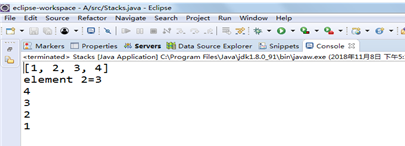
示例3:
import java.util.*;
class Counter {
int i = 1;
public String toString() {
return Integer.toString(i);
}
}
public class Statistics {
public static void main(String[] args) {
Hashtable ht = new Hashtable();//生成集合类Hashtable
for (int i = 0; i < 10000; i++) //生成循环体
{
Integer r = new Integer((int) (Math.random() * 20));//随机生成实数定义为整型
if (ht.containsKey(r))
((Counter) ht.get(r)).i++;//用来判断r是否为一个间值
else
ht.put(r, new Counter());//创建新的Counter对象
}
System.out.println(ht);
}
}
结果如下:

测试程序2:
l 使用JDK命令编辑运行ArrayListDemo和LinkedListDemo两个程序,结合程序运行结果理解程序;
import java.util.*;
public class ArrayListDemo {
public static void main(String[] argv) {
ArrayList al = new ArrayList();
//用Add来添加对象且可以重载
// Add lots of elements to the ArrayList...
al.add(new Integer(11));
al.add(new Integer(12));
al.add(new Integer(13));
al.add(new String("hello"));
System.out.println(al.size());//输出al的长度
// First print them out using a for loop.
System.out.println("Retrieving by index:");
for (int i = 0; i < al.size(); i++) {
System.out.println("Element " + i + " = " + al.get(i));
}
}
}
ArrayListDemo
结果如下:
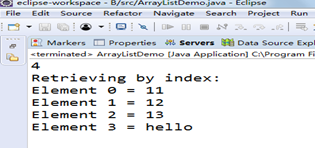
mport java.util.*;
public class LinkedListDemo {
public static void main(String[] argv) {
LinkedList l = new LinkedList();
l.add(new Object());
l.add("Hello");
l.add("zhangsan");//add方法可以重载 ListIterator li = l.listIterator(0);//迭代器生成li对象
while (li.hasNext())//hasNext方法用来返回迭代器的对象
System.out.println(li.next());
if (l.indexOf("Hello") < 0) //生成循环语句判断最后结果
System.err.println("Lookup does not work");
else
System.err.println("Lookup works");
}
}
LinkedListDemo
结果如下:

测试程序3:
l 运行SetDemo程序,结合运行结果理解程序;
import java.util.*;
public class SetDemo {
public static void main(String[] argv) {
HashSet h = new HashSet(); //也可以 Set h=new HashSet()
h.add("One");
h.add("Two");
h.add("One"); // DUPLICATE
h.add("Three");
Iterator it = h.iterator();
while (it.hasNext()) //hasNext方法
{
System.out.println(it.next());
}
}
}
SetDemo
结果如下:
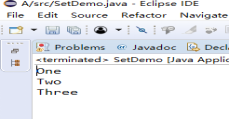
- 在Elipse环境下调试教材365页程序9-2,结合运行结果理解程序;了解HashSet类的用途及常用API。
package set; import java.util.*; /**
* This program uses a set to print all unique words in System.in.
* @version 1.12 2015-06-21
* @author Cay Horstmann
*/
public class SetTest
{
public static void main(String[] args)
{ Set<String> words = new HashSet<>(); // HashSet implements Set
long totalTime = 0; try (Scanner in = new Scanner(System.in))
{
while (in.hasNext())//迭代器的用法,判断当前元素是否存在
{
String word = in.next();//指向下一个元素
long callTime = System.currentTimeMillis();
words.add(word);//
callTime = System.currentTimeMillis() - callTime;
totalTime += callTime;
}
} Iterator<String> iter = words.iterator();//迭代器的简单实现
for (int i = 1; i <= 20 && iter.hasNext(); i++)
System.out.println(iter.next());
System.out.println(". . .");
System.out.println(words.size() + " distinct words. " + totalTime + " milliseconds.");
}
}
小结:HashSet类中存放的对象不能重复,不能保证元素的排列顺序,顺序有可能发生变化。
在Elipse环境下调试教材367页-368程序9-3、9-4,结合程序运行结果理解程序;了解TreeSet类的用途及常用API。
package treeSet; import java.util.*; /**
* This program sorts a set of item by comparing their descriptions.
* @version 1.12 2015-06-21
* @author Cay Horstmann
*/
public class TreeSetTest
{
public static void main(String[] args)
{
SortedSet<Item> parts = new TreeSet<>();
parts.add(new Item("Toaster", 1234));//add方法
parts.add(new Item("Widget", 4562));
parts.add(new Item("Modem", 9912));
System.out.println(parts); NavigableSet<Item> sortByDescription = new TreeSet<>(
Comparator.comparing(Item::getDescription)); sortByDescription.addAll(parts);
System.out.println(sortByDescription);
}
}
TreeSetTest
package treeSet; import java.util.*; /**
* An item with a description and a part number.
*/
public class Item implements Comparable<Item>//Item类实现Comparable接口
{
private String description;
private int partNumber; /**
* Constructs an item.
*
* @param aDescription
* the item's description
* @param aPartNumber
* the item's part number
*/
public Item(String aDescription, int aPartNumber)
{
description = aDescription;//字符串
partNumber = aPartNumber;
} /**
* Gets the description of this item.
*
* @return the description
*/
public String getDescription()
{
return description;
} public String toString()
{
return "[description=" + description + ", partNumber=" + partNumber + "]";
}//返回该对象的字符串表示 public boolean equals(Object otherObject)
{
if (this == otherObject) return true;
if (otherObject == null) return false;
if (getClass() != otherObject.getClass()) return false;
Item other = (Item) otherObject;
return Objects.equals(description, other.description) && partNumber == other.partNumber;
} public int hashCode()
{
return Objects.hash(description, partNumber);
} public int compareTo(Item other)
{
int diff = Integer.compare(partNumber, other.partNumber);
return diff != 0 ? diff : description.compareTo(other.description);
}
}
Item
结果如下:

小结:TreeSet是一种自带排序的set,TreeSet可以确保集合元素处于排序状态。TreeSet支持两种排序方式,自然排序 和定制排序。
测试程序4:
使用JDK命令运行HashMapDemo程序,结合程序运行结果理解程序;
import java.util.*;
public class HashMapDemo {
public static void main(String[] argv) {
HashMap h = new HashMap();
// The hash maps from company name to address.
h.put("Adobe", "Mountain View, CA");//定义对象
h.put("IBM", "White Plains, NY");
h.put("Sun", "Mountain View, CA");
String queryString = "Adobe";
String resultString = (String)h.get(queryString);
System.out.println("They are located in: " + resultString);
}
}
结果如下:

l 在Elipse环境下调试教材373页程序9-6,结合程序运行结果理解程序;
package map; import java.util.*; /**
* This program demonstrates the use of a map with key type String and value type Employee.
* @version 1.12 2015-06-21
* @author Cay Horstmann
*/
public class MapTest
{
public static void main(String[] args)
{
Map<String, Employee> staff = new HashMap<>();//HashMap implements Map
staff.put("144-25-5464", new Employee("Amy Lee"));
staff.put("567-24-2546", new Employee("Harry Hacker"));
staff.put("157-62-7935", new Employee("Gary Cooper"));
staff.put("456-62-5527", new Employee("Francesca Cruz")); // print all entries System.out.println(staff); // remove an entry staff.remove("567-24-2546"); // replace an entry staff.put("456-62-5527", new Employee("Francesca Miller")); // look up a value System.out.println(staff.get("157-62-7935")); // iterate through all entries staff.forEach((k, v) ->
System.out.println("key=" + k + ", value=" + v));
}
}
结果如下:

l 实验2:结对编程练习:
关于结对编程:以下图片是一个结对编程场景:两位学习伙伴坐在一起,面对着同一台显示器,使用着同一键盘,同一个鼠标,他们一起思考问题,一起分析问题,一起编写程序。
l 关于结对编程的阐述可参见以下链接:
http://www.cnblogs.com/xinz/archive/2011/08/07/2130332.html
http://en.wikipedia.org/wiki/Pair_programming
l 对于结对编程中代码设计规范的要求参考:
http://www.cnblogs.com/xinz/archive/2011/11/20/2255971.html
以下实验,就让我们来体验一下结对编程的魅力
l 确定本次实验结对编程合作伙伴;
l 各自运行合作伙伴实验九编程练习1,结合使用体验对所运行程序提出完善建议;
l 各自运行合作伙伴实验十编程练习2,结合使用体验对所运行程序提出完善建议;
1、合作伙伴:张燕
- 采用结对编程方式,与学习伙伴合作完成实验九编程练习1;
package xinxi; import java.io.BufferedReader;
import java.io.File;
import java.io.FileInputStream;
import java.io.FileNotFoundException;
import java.io.IOException;
import java.io.InputStreamReader;
import java.util.ArrayList;
import java.util.Arrays;
import java.util.Collections;
import java.util.Scanner; public class xinxi{
private static ArrayList<Student> studentlist;
public static void main(String[] args) {
studentlist = new ArrayList<>();
Scanner scanner = new Scanner(System.in);
File file = new File("F:\\身份证号.txt");
try {
FileInputStream fis = new FileInputStream(file);
BufferedReader in = new BufferedReader(new InputStreamReader(fis));
String temp = null;
while ((temp = in.readLine()) != null) { Scanner linescanner = new Scanner(temp); linescanner.useDelimiter(" ");
String name = linescanner.next();
String number = linescanner.next();
String sex = linescanner.next();
String age = linescanner.next();
String province =linescanner.nextLine();
Student student = new Student();
student.setName(name);
student.setnumber(number);
student.setsex(sex);
int a = Integer.parseInt(age);
student.setage(a);
student.setprovince(province);
studentlist.add(student); }
} catch (FileNotFoundException e) {
System.out.println("学生信息文件找不到");
e.printStackTrace();
} catch (IOException e) {
System.out.println("学生信息文件读取错误");
e.printStackTrace();
}
boolean isTrue = true;
while (isTrue) {
System.out.println("输入序号进行相应的操作");
System.out.println("1.字典排序");
System.out.println("2.输出年龄最大和年龄最小的人");
System.out.println("3.查找与你年龄相近的人");
System.out.println("4.查找你的同乡");
String n = scanner.next();
switch (n) {
case "1":
Collections.sort(studentlist);
System.out.println(studentlist.toString());
break;
case "2":
int max=0,min=100;
int j,k1 = 0,k2=0;
for(int i=1;i<studentlist.size();i++)
{
j=studentlist.get(i).getage();
if(j>max)
{
max=j;
k1=i;
}
if(j<min)
{
min=j;
k2=i;
} }
System.out.println("年龄最大:"+studentlist.get(k1));
System.out.println("年龄最小:"+studentlist.get(k2));
break;
case "3":
System.out.println("年龄:");
int yourage = scanner.nextInt();
int near=agenear(yourage);
int value=yourage-studentlist.get(near).getage();
System.out.println("和你年龄相近的是"+studentlist.get(near));
break; case "4":
System.out.println("输入你的家乡");
String find = scanner.next();
String place=find.substring(0,3);
for (int i = 0; i <studentlist.size(); i++)
{
if(studentlist.get(i).getprovince().substring(1,4).equals(place))
System.out.println("你的同乡是 "+studentlist.get(i));
}
break; }
}
}
public static int agenear(int age) {
int j=0,min=53,value=0,k=0;
for (int i = 0; i < studentlist.size(); i++)
{
value=studentlist.get(i).getage()-age;
if(value<0) value=-value;
if (value<min)
{
min=value;
k=i;
}
}
return k; } }
xinxi
package xinxi;
public class Student implements Comparable<Student> { private String name;
private String number ;
private String sex ;
private int age;
private String province; public String getName() {
return name;
}
public void setName(String name) {
this.name = name;
}
public String getnumber() {
return number;
}
public void setnumber(String number) {
this.number = number;
}
public String getsex() {
return sex ;
}
public void setsex(String sex ) {
this.sex =sex ;
}
public int getage() { return age;
}
public void setage(int age) {
this.age= age;
} public String getprovince() {
return province;
}
public void setprovince(String province) {
this.province=province ;
} public int compareTo(Student o) {
return this.name.compareTo(o.getName());
} public String toString() {
return name+"\t"+sex+"\t"+age+"\t"+number+"\t"+province+"\n";
}
}
class

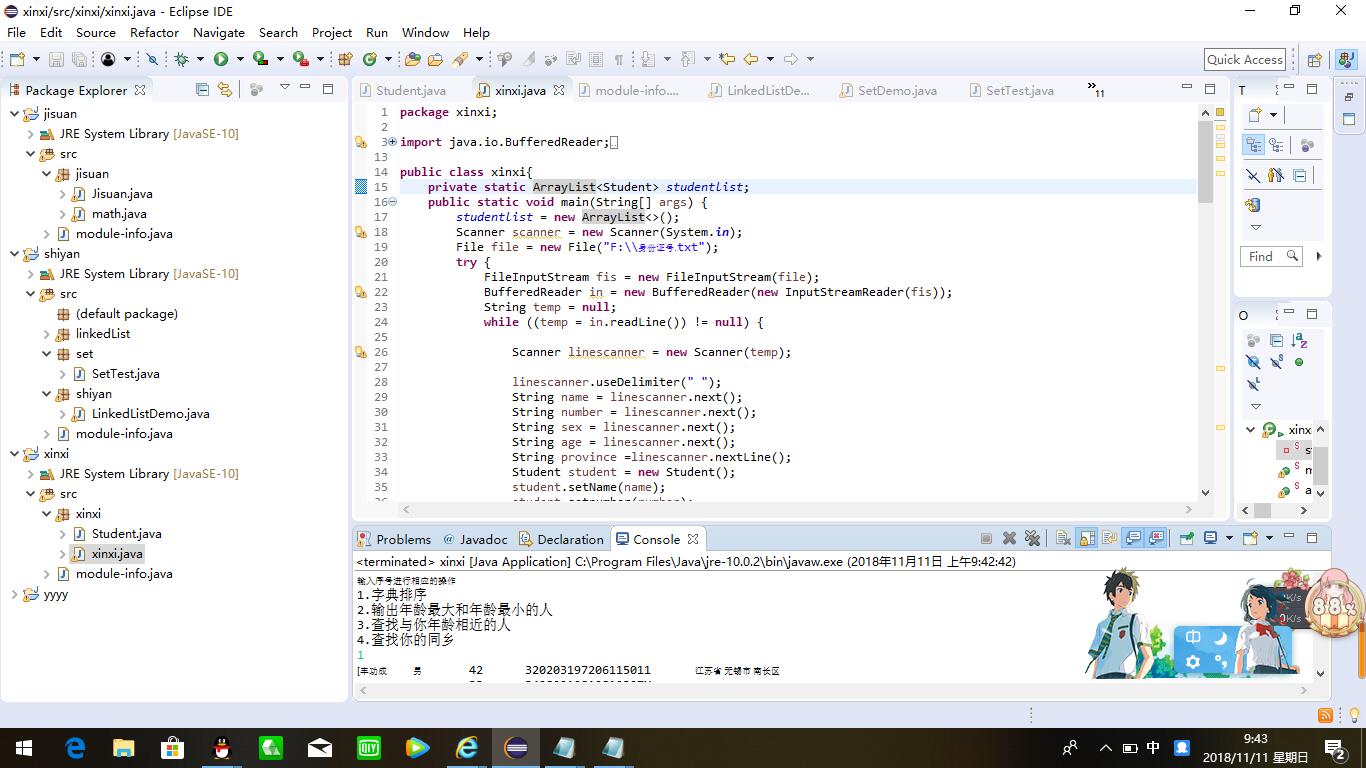
心得:通过测试,可以体会到小伙伴的代码与我的不同之处,需要学习的还很多。
- 采用结对编程方式,与学习伙伴合作完成实验十编程练习2。
package S; import java.io.*;
import java.io.PrintWriter;
import java.util.Scanner; public class jisuan {
public static void main(String[] args) { Scanner in = new Scanner(System.in); PrintWriter output = null;
try {
output = new PrintWriter("text.txt");
} catch (FileNotFoundException e) {
// TODO Auto-generated catch block
e.printStackTrace();
}
int sum = 0;
for (int i = 1; i <= 10; i++) {
int a = (int) Math.round(Math.random() * 100);
int b = (int) Math.round(Math.random() * 100);
int m = (int) Math.round(Math.random() * 4);
switch (m) {
case 1:
while (b == 0) {
b = (int) Math.round(Math.random() * 100);
}
while (a % b != 0) {
a = (int) Math.round(Math.random() * 100);
}
System.out.println(a + "/" + b + "=");
int c1 = in.nextInt();
output.println(a + "/" + b + "=" + c1);
if (c1 == a / b) {
System.out.println("恭喜答案正确");
sum += 10;
} else {
System.out.println("抱歉,答案错误");
} break; case 2:
System.out.println( a + "*" + b + "=");
int c2 = in.nextInt();
output.println(a + "*" + b + "=" + c2);
if (c2 == a * b) {
System.out.println("恭喜答案正确");
sum += 10;
} else {
System.out.println("抱歉,答案错误");
}
break;
case 3:
System.out.println( a + "+" + b + "=");
int c3 = in.nextInt();
output.println(a + "+" + b + "=" + c3);
if (c3 == a + b) {
System.out.println("恭喜答案正确");
sum += 10;
} else {
System.out.println("抱歉,答案错误");
} break;
case 4:
while (a < b) {
a = (int) Math.round(Math.random() * 100);
}
System.out.println( a + "-" + b + "=");
int c4 = in.nextInt();
output.println(a + "-" + b + "=" + c4);
if (c4 == a - b) {
System.out.println("恭喜答案正确");
sum += 10;
} else {
System.out.println("抱歉,答案错误");
}
break; } }
System.out.println("成绩" + sum);
output.println("成绩" + sum);
output.close();
}
}
jisuan
package S;
public class math<T> {
private T a;
private T b; public int add(int a, int b) {
return a + b;
} public int reduce(int a, int b) {
return a - b;
} public int multiplication(int a, int b) {
return a * b;
} public int division(int a, int b) {
if (b != 0 && a % b == 0)
return a / b;
else
return 0;
}
}
math

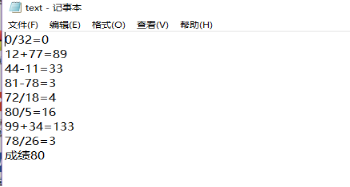
心得:合作小伙伴代码写的很多很详细,我从中学到了很多知识,如果可以的话,可以在代码的精简上多做些功夫。
2) 结对编程代码;
实验九编程练习1:
package xinxi; import java.io.BufferedReader;
import java.io.File;
import java.io.FileInputStream;
import java.io.FileNotFoundException;
import java.io.IOException;
import java.io.InputStreamReader;
import java.util.ArrayList;
import java.util.Arrays;
import java.util.Collections;
import java.util.Scanner; public class xinxi{
private static ArrayList<Student> studentlist;
public static void main(String[] args) {
studentlist = new ArrayList<>();
Scanner scanner = new Scanner(System.in);
File file = new File("F:\\身份证号.txt");
try {
FileInputStream fis = new FileInputStream(file);
BufferedReader in = new BufferedReader(new InputStreamReader(fis));
String temp = null;
while ((temp = in.readLine()) != null) { Scanner linescanner = new Scanner(temp); linescanner.useDelimiter(" ");
String name = linescanner.next();
String number = linescanner.next();
String sex = linescanner.next();
String age = linescanner.next();
String province =linescanner.nextLine();
Student student = new Student();
student.setName(name);
student.setnumber(number);
student.setsex(sex);
int a = Integer.parseInt(age);
student.setage(a);
student.setprovince(province);
studentlist.add(student); }
} catch (FileNotFoundException e) {
System.out.println("学生信息文件找不到");
e.printStackTrace();
} catch (IOException e) {
System.out.println("学生信息文件读取错误");
e.printStackTrace();
}
boolean isTrue = true;
while (isTrue) {
System.out.println("输入序号进行相应的操作");
System.out.println("1.字典排序");
System.out.println("2.输出年龄最大和年龄最小的人");
System.out.println("3.查找与你年龄相近的人");
System.out.println("4.查找你的同乡");
String n = scanner.next();
switch (n) {
case "1":
Collections.sort(studentlist);
System.out.println(studentlist.toString());
break;
case "2":
int max=0,min=100;
int j,k1 = 0,k2=0;
for(int i=1;i<studentlist.size();i++)
{
j=studentlist.get(i).getage();
if(j>max)
{
max=j;
k1=i;
}
if(j<min)
{
min=j;
k2=i;
} }
System.out.println("年龄最大:"+studentlist.get(k1));
System.out.println("年龄最小:"+studentlist.get(k2));
break;
case "3":
System.out.println("年龄:");
int yourage = scanner.nextInt();
int near=agenear(yourage);
int value=yourage-studentlist.get(near).getage();
System.out.println("和你年龄相近的是"+studentlist.get(near));
break; case "4":
System.out.println("输入你的家乡");
String find = scanner.next();
String place=find.substring(0,3);
for (int i = 0; i <studentlist.size(); i++)
{
if(studentlist.get(i).getprovince().substring(1,4).equals(place))
System.out.println("你的同乡是 "+studentlist.get(i));
}
break; }
}
}
public static int agenear(int age) {
int j=0,min=53,value=0,k=0;
for (int i = 0; i < studentlist.size(); i++)
{
value=studentlist.get(i).getage()-age;
if(value<0) value=-value;
if (value<min)
{
min=value;
k=i;
}
}
return k; } }
xinxi
package xinxi;
public class Student implements Comparable<Student> { private String name;
private String number ;
private String sex ;
private int age;
private String province; public String getName() {
return name;
}
public void setName(String name) {
this.name = name;
}
public String getnumber() {
return number;
}
public void setnumber(String number) {
this.number = number;
}
public String getsex() {
return sex ;
}
public void setsex(String sex ) {
this.sex =sex ;
}
public int getage() { return age;
}
public void setage(int age) {
this.age= age;
} public String getprovince() {
return province;
}
public void setprovince(String province) {
this.province=province ;
} public int compareTo(Student o) {
return this.name.compareTo(o.getName());
} public String toString() {
return name+"\t"+sex+"\t"+age+"\t"+number+"\t"+province+"\n";
}
}
Student
实验十编程练习2:
package C; import java.io.FileNotFoundException;
import java.io.PrintWriter;
import java.util.Random;
import java.util.Scanner; public class Main {
public static void main(String[] args) {
Scanner in = new Scanner(System.in);
Suanfa counter = new Suanfa();
PrintWriter out = null;
try {
out = new PrintWriter("test.txt");
} catch (FileNotFoundException e) {
System.out.println("文件夹输出失败");
e.printStackTrace();
} int sum = 0; for (int i = 1; i <= 10; i++) {
int a = (int) Math.round(Math.random() * 100);
int b = (int) Math.round(Math.random() * 100);
int m;
Random rand = new Random();
m = (int) rand.nextInt(4) + 1;
System.out.println("随机生成的四则运算类型:" + m); switch (m) {
case 1:
a = b + (int) Math.round(Math.random() * 100);
while(b == 0){
b = (int) Math.round(Math.random() * 100);
}
while(a % b != 0){
a = (int) Math.round(Math.random() * 100);
}
//若生成的除法式子必须能整除,且满足分母为0的条件,则a一定要大于b,且a模b的结果要为0。
System.out.println(i + ": " + a + "/" + b + "=");
int c0 = in.nextInt();
out.println(a + "/" + b + "=" + c0);
if (c0 == counter.d(a, b)) {
sum += 10;
System.out.println("正确!");
} else {
System.out.println("错误!");
}
break; case 2:
System.out.println(i + ": " + a + "*" + b + "=");
int c = in.nextInt();
out.println(a + "*" + b + "=" + c);
if (c == counter.m(a, b)) {
sum+= 10;
System.out.println("正确!");
} else {
System.out.println("错误!");
}
break;
case 3:
System.out.println(i + ": " + a + "+" + b + "=");
int c1 = in.nextInt();
out.println(a + "+" + b + "=" + c1);
if (c1 == counter.add(a, b)) {
sum += 10;
System.out.println("正确!");
} else {
System.out.println("错误!");
}
break;
case 4:
while (a < b) {
b = (int) Math.round(Math.random() * 100);
}
//因为不能产生运算结果为负数的减法式子,所以a一定要大于b。若a<b,则重新生成b。
System.out.println(i + ": " + a + "-" + b + "=");
int c2 = in.nextInt();
out.println(a + "-" + b + "=" + c2);
if (c2 == counter.r(a, b)) {
sum += 10;
System.out.println("正确!");
} else {
System.out.println("错误!");
}
break;
}
}
System.out.println("成绩" + sum);
out.println("成绩:" + sum);
out.close();
}
}
Main
package C;
public class Suanfa<T> {
private T a;
private T b;
public int add(int a,int b) {
return a + b;
} public int r(int a, int b) {
return a - b;
} public int m(int a, int b) {
return a * b;
} public int d(int a, int b) {
if (b != 0 && a%b==0)
return a / b;
else
return 0;
}
}
Suanfa
3) 结对程序运行功能界面截图;

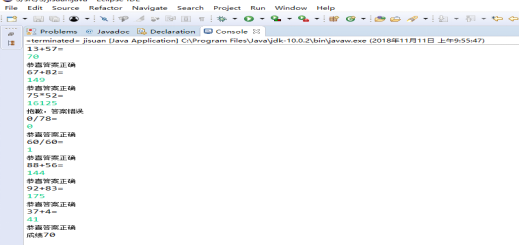
4) 结对过程描述,提供两人在讨论、细化和编程时的结对照片(非摆拍)
在测试过互相的程序后,发现了各自的不足之处,以后会加以改进,然后我们二人又重新开始对以上的程序进行了修改,简化,得出了结果,果然合作的话会有更大的发展空间,还能发现更多的问题。
总结:本章我们学习了Vetor、Stack、Hashtable三个类的用途及常用API;我在测试代码实验中,通过注释,编译逐渐理解了本周理论知识所讲的知识,感受到了它们的区别和联系,在本周实验中还增加了一个结对实验,这个合作实验让我们发现了彼此的不足和需要改进的地方,是 个很好的相互学习的过程。
201771010135 杨蓉庆AND张燕 《面对对象程序设计(java)》第十一周学习总结的更多相关文章
- 201771010135 杨蓉庆/张燕《面对对象程序设计(java)》第十三周学习总结
1.实验目的与要求 (1) 掌握事件处理的基本原理,理解其用途: (2) 掌握AWT事件模型的工作机制: (3) 掌握事件处理的基本编程模型: (4) 了解GUI界面组件观感设置方法: (5) 掌握W ...
- 201771010134杨其菊《面向对象程序设计java》第九周学习总结
第九周学习总结 第一部分:理论知识 异常.断言和调试.日志 1.捕获 ...
- 201771010135 杨蓉庆/张燕/杨玲《面对对象程序设计(java)》第十四周学习总结
1.实验目的与要求 (1) 掌握GUI布局管理器用法: (2) 掌握各类Java Swing组件用途及常用API 一.理论知识 Swing和MVC设计模式 (1)设计模式(Design patte ...
- 201771010135 杨蓉庆《面对对象程序设计(java)》第十八周学习总结
1.实验目的与要求 (1) 综合掌握java基本程序结构: (2) 综合掌握java面向对象程序设计特点: (3) 综合掌握java GUI 程序设计结构: (4) 综合掌握java多线程编程模型: ...
- 201771010135 杨蓉庆《面对对象程序设计(java)》第十七周学习总结
1.实验目的与要求 (1) 掌握线程同步的概念及实现技术: (2) 线程综合编程练习 一.理论知识 ⚫ 线程同步 (1)多线程并发运行不确定性问题解决方案:引入线 程同步机制,使得另一线程要使用该方法 ...
- 201771010135 杨蓉庆《面对对象程序设计(java)》第十六周学习总结
1.实验目的与要求 (1) 掌握线程概念: (2) 掌握线程创建的两种技术: (3) 理解和掌握线程的优先级属性及调度方法: (4) 掌握线程同步的概念及实现技术: 一.理论知识 ⚫ 线程的概念 (1 ...
- 201771010135 杨蓉庆《面对对象程序设计(java)》第十五周学习总结
1.实验目的与要求 (1) 掌握Java应用程序的打包操作: (2) 了解应用程序存储配置信息的两种方法: (3) 掌握基于JNLP协议的java Web Start应用程序的发布方法: (5) 掌握 ...
- 201771010135 杨蓉庆《面对对象程序设计(java)》第十二周学习总结
1.实验目的与要求 (1) 掌握Java GUI中框架创建及属性设置中常用类的API: (2) 掌握Java GUI中2D图形绘制常用类的API: (3) 了解Java GUI中2D图形中字体与颜色的 ...
- 201771010135 杨蓉庆《面对对象程序设计(java)》第十周学习总结
1.实验目的与要求 (1) 理解泛型概念: (2) 掌握泛型类的定义与使用: (3) 掌握泛型方法的声明与使用: (4) 掌握泛型接口的定义与实现: (5)了解泛型程序设计,理解其用途. 一.理论知识 ...
随机推荐
- Exception in thread "http-apr-8080-exec-1" java.lang.StackOverflowError
Exception in thread "http-apr-8080-exec-1" java.lang.StackOverflowError 可能执行了递归,陷入了死循环 如下我 ...
- 编码 - 调整 gitbash 文本字符集
概述 gitbash 设置 文本字符集 背景 最近被 编码 的事情搞得乱七八糟 有点没头绪, 所以碰到 编码相关 的东西, 都想看上一看 环境 os win10.1903 git 2.20.1 1. ...
- Linux 虚拟机共享目录
1. 开启linux虚拟机 2. 菜单“虚拟机” -------“重新安装 Vm tools” 3. 桌面看到 VmTools 安装盘 4. 安装 5. 设置中添加共享目录 5. ...
- (转)数据索引BTree
.B-tree 转自:http://blog.csdn.net/hbhhww/article/details/8206846 B-tree又叫平衡多路查找树.一棵m阶的B-tree (m叉树)的特性如 ...
- python3练习100题——006
继续做题-经过py3测试 原题链接:http://www.runoob.com/python/python-exercise-example6.html 题目:斐波那契数列. 我的代码: def fi ...
- Web设计精髓(转)
作者:zhouwenqi 地址:http://www.zhouwenqi.com/blog/board_43.html 这篇文章说实际问题的,所以不多强调,下面是我总结的一些比较突出的细节问题,而且 ...
- Java-POJ1013-Counterfeit Dollar
在13枚硬币中找出fake的那一个 输入:三次天平称量结果 package poj.ProblemSet; import java.util.Scanner; /* 我怎么觉得是贪心算法呢? 起初对所 ...
- AcWing 285. 没有上司的舞会
//f[u][0]是所有以u为根的子树中选择,并且不选u这个点的方案 //f[u][1]是所有以u为根的子树中选择,并且 选u这个点的方案 #include <cstring> #incl ...
- MyEcplise中编码格式的修改问题
1.如果是在Run Configurations中修改编码格式的话,只能是修改当前java文件的编码格式,把改文件中的代码复制到 另一新建 的java文件中会出现异常,所以就会出现相同的代码在两个不同 ...
- MySQL8.0服务启动(windows10)
mysql下载地址:https://dev.mysql.com/downloads/mysql/ 根目录下配置文件:my.ini [mysqld]# 设置3306端口port=3306# 设置mysq ...
